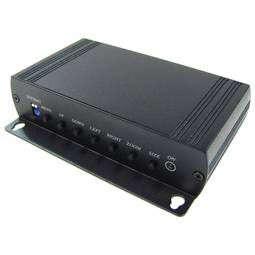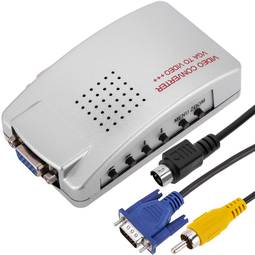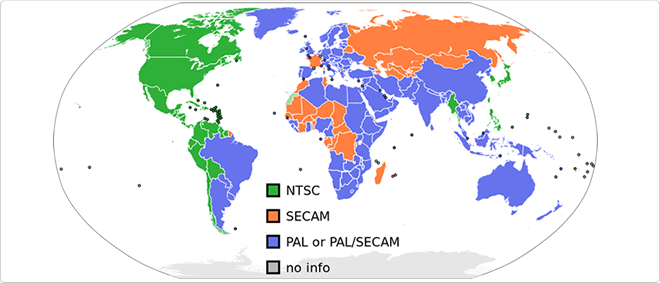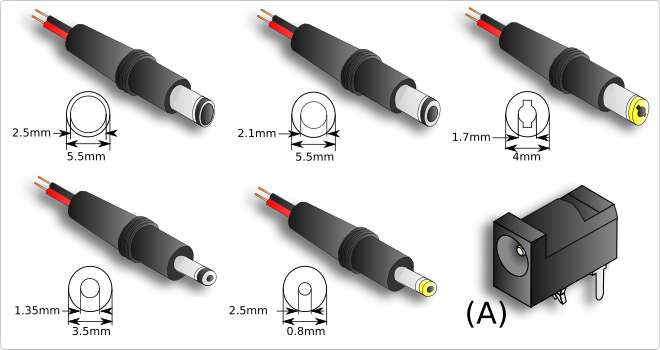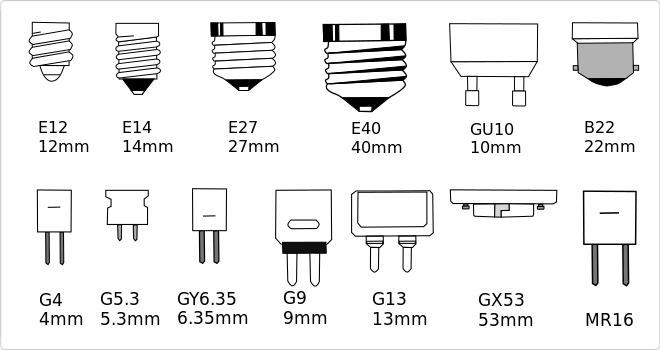USB
The USB (Universal Serial Bus) is a standard that defines the cables, connectors and used a bus to connect, communicate, computers, peripherals and electronic devices protocols Transmission Rates Low speed (USB 1.0). Transfer rate up to 1.5 Mbit/s (188 kB/s) used in keyboard, mouse ... transfer rate up to 12 Mbit/s (1.5 MB/s) High Speed ??(USB 2.0): Rate transferencia up to 480 Mbit/s (60 MB/s) SuperSpeed ??(USB 3.0) transfer rate up to 4.8 Gbit/s (600 MB/s) Connector Types 1 - USB type A (4 pin) 2. - USB type B (4 pin) 3 - Mini A (5-pin) 4 - Mini B (5-pin) 5 - Micro A (5-pin) 6 - Micro B (5-pin)
VGA
The term VGA (Video Graphics Array or Video Graphics Adapter) is a graphics display system for PCs developed by IBM. VGA has become one of the standards for the PC image. In text mode, VGA provides a resolution of 720 by 400 pixels. In graphics mode, the resolution is either 640 by 480 (with 16 colors) or 320 by 200 (with 256 colors). The color palette is 262,144.Unlike earlier graphic standards for PCs - MDA, CGA, EGA and VGA - uses analog signals rather than digital signals. Since its introduction in 1987, several other standards have been developed that offer greater resolution and more colors (SVGA, XGA ...), but VGA remains the denominator used. All personal computers manufactured today still have support VGA, and possibly some other more advanced connection.
MicroUSB
or horizontal. The micro USB with five pins, which pins identification (ID) Micro AB USB connectors special work. AB connectors with pin ID can allow the device to function as a connector A or B to standard USB technology. This gives the new smart phones and other devices the option to act as either a single storage device or as provi
Mini USB
The mini USB connectors are smaller than their standard counterparts and have USB fifth pin. The fifth pin is known as the pin ID and is typically not used in mini USB connectors. It was designed to allow later improved USB technology. The mini USB connectors have a cycle life of at least 5000 connections and disconnections, which accommodates the mobile nature of the devices that are designed to interact. The standard USB connectors are generally used with devices that are stationary and not disconnected often.
NTSC and PAL
NTSC and PAL are the two coding systems for television signals, each other, they are totally incompatible. NTSC is mainly used in the United States, while the PAL system is one that is typically used in Europe. PAL: 720 x 576 pixels and 25 frames per second NTSC: 720 x 480 pixels and 29.9 frames per second.
MiniDin
The mini-DIN connector designates a family of circular connectors, each with a diameter of 9.5 mm and a varied number of pins inside. Although initially designed as mere electrical connectors, they are very popular in electronics and computers, having succeeded the larger DIN connector. Both are standards of Deutsches Institut für Normung, the German standardization body.
USB 3.0
USB 3.0 is the second major revision of the standard Universal Serial Bus (USB) connectivity for computing. USB 3.0 has transmission speeds of up to 5 Gbit/s, which is 10 times faster than USB 2.0 (480 Mbit/s). Connector Types 1 - USB type A plug 2 - 3 USB type A female - USB type B 4 - Micro USB B
SCART - SCART
The SCART is a standard 21-pin connections or that exchanges information audio and video connector. Pin 1 Audio output right channel Pin 2 Input Pin 3 right audio channel Audio output left channel Pin 4 Pin 5 audios mass Mass of blue (blue) (RGB)/Mass Chroma input Pin 6 Audio left channel Pin 7 Blue input signal (RGB)/Chroma Input Pin 8 Change ancho screen 0 6 Volts Volts No signal screen 16: 9 12V Screen 4: 3 Pin 9 mass of green (RGB) input D²B Pin 10 Pin 11 Entry signal green (RGB) Output Pin 12 Pin 13 Mass D²B color Red (RGB)/Mass output Mass D²B Chroma Pin 14 Pin 15 red signal input (RGB)/Chroma Output Pin 16 RGB composite video switching 0V Pin 1 Volt RGB output 17 Mass compues videoto/Sync output Mass/Mass luminance output Pin 18 input Composite Mass/Mass Sync input/Mass switching to RGB/Luminance input Masa 19 Pin output Composite/Sync output video/Video luminance output Pin 20 Composite video/Sync input/luminance input connector Pin 21 Mass
Reversible USB Type-C
USB-C reversible USB version called USB cables USB Type C Type C or USB reversible. The important thing is this type of USB is that it has top and bottom. So you may save the blows that are given involuntarily to connect the connector upside down. It is also characterized in that when connected will make an audible "click". The USB-C or reversible USB cables can reach 10 Gbps and support USB 3.0, 3.1Use is estimated up to 10,000 applications and has some measures 8.4mm x 2.6mm is also compatible with USB 3.1 and USB indicate creators
CVBS
CVBS is the acronym by which composite video is often referred to. The idea of this definition means Color, Video, Erase and Synchronized.
The most widely used cable is the already known coaxial cables with a BNC connector or RCA connector.
RCA
The RCA (Radio Corporation of America) connector is a connector used to send video signals or audio.
This is a circular two-contact connector; signal and ground, used with coaxial cables. Each signal uses a single cable and to differentiate color coded RCA connector on the set.
(1) Analog Audio:
Audio Left (White)
Audio Right (Red)
(2) Videoanalogical:
Video (Yellow)
(3) Composite Video:
Audio Left (White)
Audio Right (Red)
Video (Yellow)
(4) Video Component (YPbPr):
Y (Green)
Pb (Blue)
Pr (Red)
(5) Video components (RGB):
R (Red)
G (Green)
B (Blue)
(6) Digital Audio:
S/PDIF (Orange/Gold)
DC jack connector
Inside the different types of connectors for power supply we find one of the most common, the DC jack. Used in most connections in electronic devices such as routers, laptops, printers etc ... is the most used due to its easy assembly and connection. These connectors are mostly used in DC power supplies and installations.
The connector is cylindricalAnd we find its version in male and female format (A). The male connector is composed of the outer and inner metal part, where in each of them the energy travels, normally the inner part is used for the positive pole and the outside for the negative, but may vary according to manufacturer.
This type of connector is found in many diameters, the most common are 3.5mm and 5.5mm. Although we can andThere are several measures in terms of length and outer or inner diameter.
Its installation is simple, we can find several types of connectors, pair to weld or to screw with terminal block, it will depend on the user to choose the most suitable in its installation.
When purchasing the male connector to perform a repair we must know its diameter, length of the connector and internal diameter. If we proceed with aTo new installation only we must make sure that the male and female connector are of the same characteristics.
![]()
Types of bulb socket
The socket is the part that allows connecting the bulb to the socket. There is a wide selection of bushings for different types of bulbs. The nomenclature for each type includes 1 or more letters (type of lampholder), followed by 1 or more numbers (diameter of lampholder).
Example: The bush E27 would correspond to the type of thread E (Edison) of 27mm in diameter.
- E12: Diameter of 12mm, this is a tamYear smaller than the most commonly used standard E27.
- E14: It is the second most common cap, only varies a little of the E27, with a diameter of 14 to 17 mm. It is normally used for bulbs or lamps.
- E27: This is the most common cap. It has a thick cup shape with thread to be able to adapt to the connector. It measures 27mm wide.
- E40: Has a diameter of 40 mm, it is the largest thread of this tIpo.
- G4: With a distance between pins of 4.0 mm. It is a type of cap that is frequently used in appliqués, ceiling lamps and hanging lamps.
- G5.3: With a distance between pins of 5.33 mm. The GU 5.3 socket format is a format widely used in small led floodlights with transformer. Usually used in halogen lamps and dichroic halogens.
- GY6.35: With a distance between pins of 6.35 mm, trOf a model similar to the previous one.
- G9: With a ditancia between pins of 9,0 mm. Usually used for ceiling lamps and hanging lamps.
- G13: With a distance between pins of 12,7 mm. It is used in fluorescent tubes.
- GX53: With distance between pins of 53 mm. Its most common use is the installation in light bulbs to illuminate furniture or unusual places. It does not need transformer.
- GU10: With a distance between10 mm pins. The GU10 bushing shape is a widely used format in small transformerless LED spotlights. Usually used in dichroic halogen lamps.
- B22: Type of bayonet connector used in countries such as Africa, India and Ireland.
- MR16: Its use is normally limited to 12V halogen lamps.
![]()





